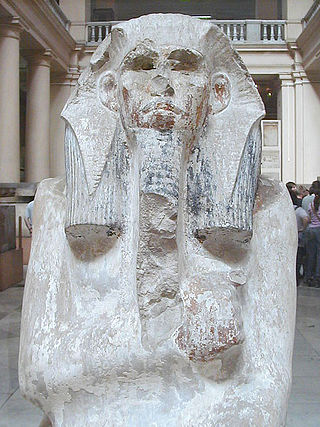
Djoser was an ancient Egyptian pharaoh of the 3rd Dynasty during the Old Kingdom, and was the founder of that epoch. He is also known by his Hellenized names Tosorthros and Sesorthos. He was the son of King Khasekhemwy and Queen Nimaathap, but whether he was also the direct successor to their throne is unclear. Most Ramesside king lists identify a king named Nebka as preceding him, but there are difficulties in connecting that name with contemporary Horus names, so some Egyptologists question the received throne sequence. Djoser is known for his step pyramid, which is the earliest colossal stone building in ancient Egypt.

Narmer was an ancient Egyptian pharaoh of the Early Dynastic Period, whose reign began at a date estimated to fall in the range 3273–2987 BC. He was the successor to the Protodynastic king Ka. Many scholars consider him the unifier of Egypt and founder of the First Dynasty, and in turn the first king of a unified Egypt. He also had a prominently noticeable presence in Canaan, compared to his predecessors and successors. Neithhotep is thought to be his queen consort or his daughter.

Edfu is an Egyptian city, located on the west bank of the Nile River between Esna and Aswan, with a population of approximately 60,000 people. Edfu is the site of the Ptolemaic Temple of Horus and an ancient settlement, Tell Edfu. About 5 km (3.1 mi) south of Edfu are remains of ancient pyramids.

Huni was an ancient Egyptian king, the last pharaoh of the Third Dynasty of Egypt during the Old Kingdom period. Based on the Turin king list, he is commonly credited with a reign of 24 years, ending c. 2613 BC.
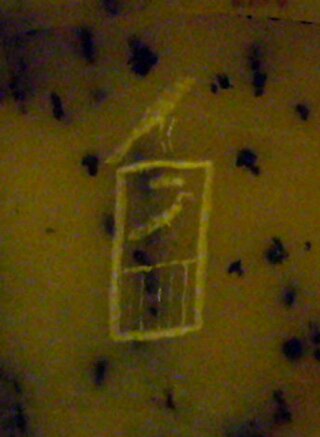
Khaba was a pharaoh of Ancient Egypt, active during the 3rd Dynasty of the Old Kingdom period. The exact time during which Khaba ruled is unknown but may have been around 2670 BC, and almost definitely towards the end of the dynasty.

Meidum, Maydum or Maidum is an archaeological site in Lower Egypt. It contains a large pyramid and several mudbrick mastabas. The pyramid was Egypt's first straight-sided one, but it partially collapsed in ancient times. The area is located around 72 kilometres (45 mi) south of modern Cairo.
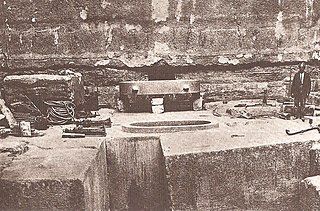
Zawyet El Aryan is a town in the Giza Governorate, located between Giza and Abusir. To the west of the town, just in the desert area, is a necropolis, referred to by the same name. Almost directly east across the Nile is Memphis. In Zawyet El Aryan, there are two pyramid complexes and five mastaba cemeteries.

The Layer Pyramid is a ruined step pyramid dating to the 3rd Dynasty of Egypt and located in the necropolis of Zawyet El Aryan. Its ownership is uncertain and may be attributable to pharaoh Khaba. The pyramid architecture, however, is very similar to that of the Buried Pyramid of king Sekhemkhet and for this reason is firmly datable to the 3rd Dynasty.

Gisr el-Mudir, also known as the Great Enclosure, is one of the oldest known stone structures in Egypt, located at Saqqara only a few hundred metres west of the Step Pyramid and the Buried Pyramid. The function of the space is not yet clear.
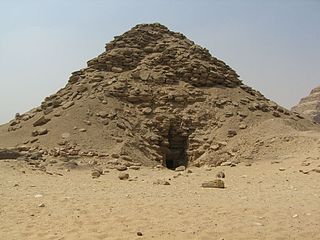
The pyramid complex of Userkaf was built c. 2490 BC for the pharaoh Userkaf, founder of the 5th Dynasty of Egypt. It is located in the pyramid field at Saqqara, on the north-east of the step pyramid of Djoser. Constructed in dressed stone with a core of rubble, the pyramid is now ruined and resembles a conical hill in the sands of Saqqara. For this reason, it is known locally as El-Haram el-Maharbish, the "Heap of Stone", and was recognized as a royal pyramid by western archaeologists in the 19th century.

The Mastabat al-Fir'aun is the grave monument of the ancient Egyptian king Shepseskaf, the last king of the Fourth Dynasty documented to date. It is located in South Saqqara halfway between the Pyramid of Djoser at Saqqara and the pyramids of Sneferu, the founder of the Fourth Dynasty, at Dahshur. The structure is located close to the pyramid of Pepi II, a ruler of the Sixth Dynasty. The stone quarry for the structure is located west of the Red Pyramid of Sneferu.

Double Falcon was a ruler of Lower Egypt from Naqada III. He may have reigned during the 32nd century BC. The length of his reign is unknown.

The pyramid of Khui is an ancient Egyptian funerary structure datable to the early First Intermediate Period and located in the royal necropolis of Dara, near Manfalut in Middle Egypt and close to the entrance of the Dakhla Oasis. It is generally attributed to Khui, a kinglet belonging either to the 8th Dynasty or a provincial nomarch proclaiming himself king in a time when central authority had broken down, c. 2150 BC. The pyramid complex of Khui included a mortuary temple and a mud brick enclosure wall which, like the main pyramid, are now completely ruined.

The pyramid of Athribis was a small mudbrick pyramid located at Athribis in the southern Nile Delta, northeast of the modern city of Banha. It was located the furthest north of all the pyramids in ancient Egypt and the only known pyramid to have been built in the Delta.
The pyramid of Elephantine is part of a group of seven very similar small step pyramids, along with the pyramids at Edfu South, el-Kula, Naqada, Zawyet el-Maiyitin, Seila, and Sinki. All of these were built far from the main centres of Egypt and are very poorly understood. The pyramid of Elephantine is located in the northwest part of the Old Kingdom city on the south end of the island of Elephantine in the Nile. The structure was discovered in 1907, but it could only be identified as a pyramid after excavations by the German Archaeological Institute in 1978–79.
The pyramid of Naqada, also called the pyramid of Ombos, is part of a group of seven very similar small step pyramids, which were all erected far from the major centres of Egypt and about which very little is known. It is located about 300 metres north of the ruins of the ancient site of Ombos, near the modern city of Naqada in Upper Egypt. The first excavation was undertaken in 1895 by Flinders Petrie and James Edward Quibell.

Ny-Hor was a possible pharaoh from the Predynastic Period. His name means "The Hunter" according to egyptologist Werner Kaiser. He may have ruled during the 31st century BC.
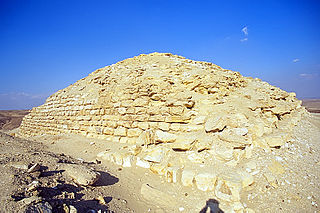
The pyramid of Seila is one of a group of seven small step pyramids which are very similar to one another, along with the Edfu South pyramid, the pyramid of Elephantine, the pyramid of El-Kula, the pyramid of Naqada, the pyramid of Zawyet el-Maiyitin, and the pyramid of Sinki. These pyramids were all built far from the major centres of Egypt and very little is known about them. The pyramid is located on an outcrop between the Faiyum Oasis and the Nile Valley, about 6 km north of the motorway from Wasta to Faiyum. Its builder may have been Snefru, the founder of the Fourth Dynasty. It was discovered in 1889/1890 by Flinders Petrie and revisited in 1898 by Ludwig Borchardt.

The Pyramid of el-Kula, along with the pyramids in Edfu-South, Elephantine, Ombos, Zawyet el-Maiyitin, Seila, and Sinki, belongs to a group of seven very similar small step pyramids that were all built far away from the major centers of Egypt and about which very little is known. It is located approximately six kilometers north of the ancient site of Hierakonpolis near the village of Naga el-Mamariya. Of all the pyramids mentioned above, it is in the best state of preservation. It was first described in 1837 by John Shae Perring and Richard William Howard Vyse, who called it el-Koofa. A thorough excavation and examination of the structure was carried out in 1949 under the direction of the Belgian Egyptologist Jean Capart.

Pyramid of Sinki is a small, layered step pyramid located approximately 5.5 km southeast of the Temple of Seti I and in Abydos, eighth nome in Upper Egypt. It was built on a sand surface, which was common for several layer step pyramids in ancient Egypt.

















